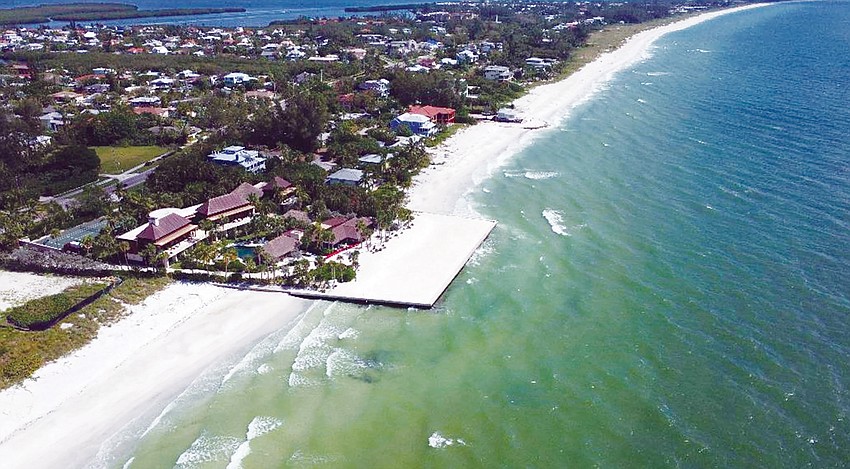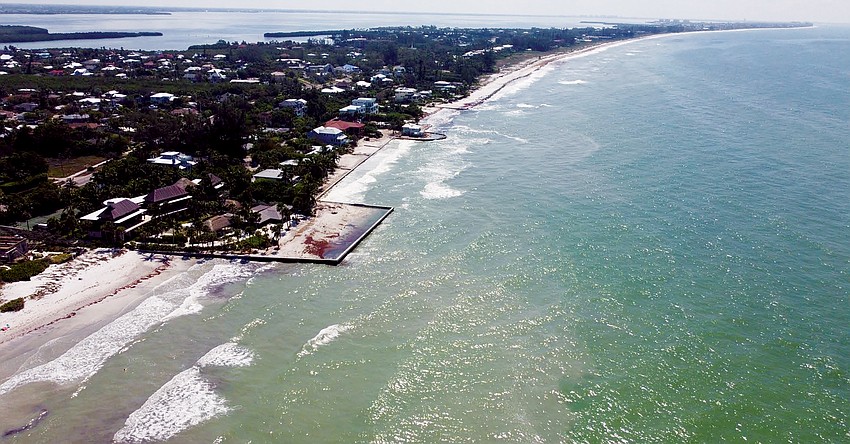- July 10, 2025
-
-
Loading

Loading

For a problem as complex as Longboat Key’s Gulfside Road, large-scale solutions are necessary.
About 2,500 feet of shoreline off Gulfside Road are in peril as the combination of a historically erosive beach and issues with private beach structures exacerbate the annual erosion problem.
If nothing is done, then the erosive pattern could continue so far that it removes the beach entirely and impacts property owners along that shoreline, said Al Browder with Olsen Associates, Inc. Browder and Olsen Associates have a long-standing relationship with Longboat Key, having worked on several past beach projects and conducting the annual beach reviews.
That drastic change could cause a domino effect that impacts the entire shoreline and downshore drift of Longboat Key.
At the Longboat Key Town Commission’s June 17 workshop, Browder presented alongside Assistant Public Works Director Charlie Mopps to inform commissioners about what needs to be done to save the Gulfside Road beach.
To address the complicated issues at Gulfside Road, Browder and Mopps said two things are necessary.
First, an interim beach nourishment that is estimated to cost around $4 million to $4.5 million and will hold the line for about two years at the beach’s current erosion rate.
Then, a condensed groin field would be the next step, installed off the Gulfside Road shoreline to stabilize the sand. This will be paired with another nourishment, which will fill the beach.
The mixture of net-negative erosion and man-made shoreline structures — most notably the Ohana estate seawall — are the key factors behind the Gulfside Road problem.
Early into Browder and Mopps’ presentation, a hypothetical was raised: If the seawalls weren’t there, would there still be an issue?
“It wouldn’t be to the degree that you experience now,” Browder said. “But the background pattern of longshore transport suggests, and I firmly believe, that you would still have an erosion problem. You would still have an ongoing, annual erosion problem.”
Most of Longboat Key is mildly erosive, according to Browder. Studies dating back to the 1990s show that, in general, Longboat Key’s beaches lose about 150,000 to 175,000 cubic yards of sand per year.


To make matters worse, Gulfside Road is on the tail end of what is called an ebb-tidal shoal coming from Longboat Pass.
Longboat Pass is a channel through which water flows. The flow of that water carries sand from one island (the updrift island) to another (the downdrift island). The north end of Longboat Key acts as the updrift island, which adds to the erosion dynamic.
The Ohana estate, which recently sold for $19.75 million, was constructed in 2013 and includes a seawall that extends from the property to the water, cutting off beach access. Following the seawall’s repairs in 2020, the property owners posted signs that made the property off-limits.
Posted signs included warnings of a guard dog that bites. This effectively caused a divide in Longboat Key’s public beach on the north end.
Seawalls can help to protect a property but usually result in loss of sand due to wave action.
“Generally, as you start to harden the shoreline, it has detrimental effects downstream,” Browder said.
The Ohana seawall protects the private property on all sides, but wave action on the sides of the seawall transports sediment away from the shoreline and worsens the beach’s already-erosive pattern, Browder said.
“You got to do something big to fix this problem,” Browder said.
Browder and Mopps said, for now, interim beach nourishment is necessary to hold the shoreline at Gulfside Road. It isn’t a viable long-term solution, but it will buy time until a long-term solution can be implemented.
The nourishment would take 80,000 cubic yards of sand from a Longboat Pass dredge and move it to the Gulfside Road shoreline.
Browder and Mopps are hopeful that a cost-sharing program through the Florida Department of Environmental Protection could cover the roughly $4 million cost. The program, in response to Hurricane Ian, provides funds for sand placement projects.
Mopps said he’s ready to apply as soon as he can on July 1 and is confident it will cover at least 27% of the costs. But it’s possible the FDEP could fund 100% of the project, according to Mopps.
Browder estimated that the amount of sand would hold for about two years.
If another hurricane has a big impact on the shoreline, like Hurricane Idalia, it could be less.
Placing sand once, though, isn’t enough to solve the problem.
“In order for a beach project to survive a significant storm and heal itself, there’s got to be more meat in the beach,” Browder said. “And you’re kind of handcuffed here, frankly, because you can’t place enough here to take that hit and then have it last for any reasonable length of time. And that’s the real, just, death spiral that you’re going down.”
To sustain the shoreline at Gulfside Road, Browder proposed a groin field of eight rock structures — seven T-head groins and one “half structure” off the Ohana seawall.

Groins are structures that are generally built perpendicular to a shoreline and help slow down sediment that's naturally carried down the shoreline.
“In essence, all we are seeking to do here is to protect the upland properties and maintain a reasonably consistent sandy beach south of the Ohana wall,” Browder said. “In order to do that, you have to put these structures out here and they have to be close enough together that they work together to create these little bays in between them.”
This will require 8,100 tons of armor stone and 80,000-90,000 cubic yards of fill. The structures would cost around $5.7 million, with another $4 million to 4.5 million for the sand. In total, Mopps said the project is estimated at around $9.7 million to $10.2 million.
Even this part of the project is complex, since Browder had to run several different options through modeling software to determine the right lengths and amount of rock structures.
Additionally, there are existing, protected hard-bottom surfaces off of the Gulfside Road shoreline. The project team would have to be careful not to disturb those reef-like surfaces, or else mitigation would be required and costly.
After hearing the problems and solutions, town commissioners raised concerns over the cost allocation for the project.
“There is a question of asking all the citizens of Longboat Key to spend $10 million on something that impacts 16 homes,” Vice Mayor Mike Haycock said. “I don’t have a strong opinion on it one way or the other, but you got to ask the question.”
District 4 Commissioner Debra Williams agreed.
“We’re talking about a very large amount of money,” Williams agreed. “To me, these numbers are much higher than any other beach renourishment that we’ve done. It’s a big concentration of cost for 16 homes.”
Browder and Mopps said that if nothing is done, all the private property owners on that shoreline could choose to armor their properties with shorelines. If that happens, it could have adverse consequences downshore.
“You’re basically removing part of the sediment flow back and forth,” Browder said. “There’s a deficit there that’s never made up.”
Browder said that, while it is a big upfront cost, this drastic of a project could alleviate the amount of sand needed in future nourishments, which could result in future savings.
The idea of a special assessment was tossed around, which Town Attorney Maggie Mooney said could be possible, but would present its own challenges.
In the meantime, commissioners agreed that if Mopps can secure 100% of the funds from FDEP for the interim nourishment it’s a no-brainer. If not, they requested Mopps to come back with an update.